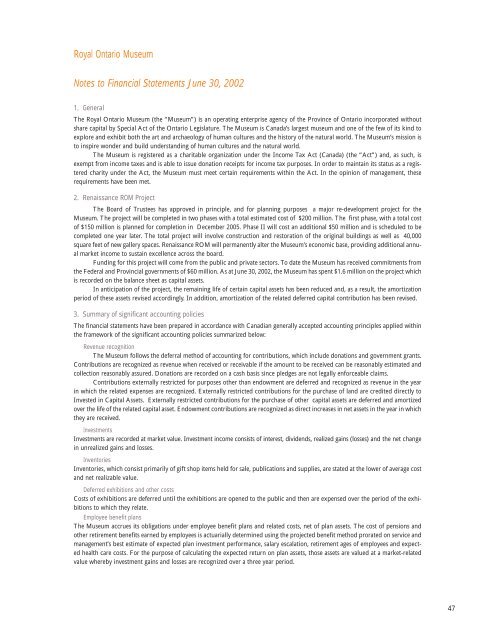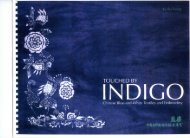AR 2001 Layout_Final - Royal Ontario Museum
AR 2001 Layout_Final - Royal Ontario Museum
AR 2001 Layout_Final - Royal Ontario Museum
You also want an ePaper? Increase the reach of your titles
YUMPU automatically turns print PDFs into web optimized ePapers that Google loves.
<strong>Royal</strong> <strong>Ontario</strong> <strong>Museum</strong><br />
Notes to Financial Statements June 30, 2002<br />
1. General<br />
The <strong>Royal</strong> <strong>Ontario</strong> <strong>Museum</strong> (the “<strong>Museum</strong>”) is an operating enterprise agency of the Province of <strong>Ontario</strong> incorporated without<br />
share capital by Special Act of the <strong>Ontario</strong> Legislature. The <strong>Museum</strong> is Canada’s largest museum and one of the few of its kind to<br />
explore and exhibit both the art and archaeology of human cultures and the history of the natural world. The <strong>Museum</strong>’s mission is<br />
to inspire wonder and build understanding of human cultures and the natural world.<br />
The <strong>Museum</strong> is registered as a charitable organization under the Income Tax Act (Canada) (the “Act”) and, as such, is<br />
exempt from income taxes and is able to issue donation receipts for income tax purposes. In order to maintain its status as a registered<br />
charity under the Act, the <strong>Museum</strong> must meet certain requirements within the Act. In the opinion of management, these<br />
requirements have been met.<br />
2. Renaissance ROM Project<br />
The Board of Trustees has approved in principle, and for planning purposes a major re-development project for the<br />
<strong>Museum</strong>. The project will be completed in two phases with a total estimated cost of $200 million. The first phase, with a total cost<br />
of $150 million is planned for completion in December 2005. Phase II will cost an additional $50 million and is scheduled to be<br />
completed one year later. The total project will involve construction and restoration of the original buildings as well as 40,000<br />
square feet of new gallery spaces. Renaissance ROM will permanently alter the <strong>Museum</strong>’s economic base, providing additional annual<br />
market income to sustain excellence across the board.<br />
Funding for this project will come from the public and private sectors. To date the <strong>Museum</strong> has received commitments from<br />
the Federal and Provincial governments of $60 million. As at June 30, 2002, the <strong>Museum</strong> has spent $1.6 million on the project which<br />
is recorded on the balance sheet as capital assets.<br />
In anticipation of the project, the remaining life of certain capital assets has been reduced and, as a result, the amortization<br />
period of these assets revised accordingly. In addition, amortization of the related deferred capital contribution has been revised.<br />
3. Summary of significant accounting policies<br />
The financial statements have been prepared in accordance with Canadian generally accepted accounting principles applied within<br />
the framework of the significant accounting policies summarized below:<br />
Revenue recognition<br />
The <strong>Museum</strong> follows the deferral method of accounting for contributions, which include donations and government grants.<br />
Contributions are recognized as revenue when received or receivable if the amount to be received can be reasonably estimated and<br />
collection reasonably assured. Donations are recorded on a cash basis since pledges are not legally enforceable claims.<br />
Contributions externally restricted for purposes other than endowment are deferred and recognized as revenue in the year<br />
in which the related expenses are recognized. Externally restricted contributions for the purchase of land are credited directly to<br />
Invested in Capital Assets. Externally restricted contributions for the purchase of other capital assets are deferred and amortized<br />
over the life of the related capital asset. Endowment contributions are recognized as direct increases in net assets in the year in which<br />
they are received.<br />
Investments<br />
Investments are recorded at market value. Investment income consists of interest, dividends, realized gains (losses) and the net change<br />
in unrealized gains and losses.<br />
Inventories<br />
Inventories, which consist primarily of gift shop items held for sale, publications and supplies, are stated at the lower of average cost<br />
and net realizable value.<br />
Deferred exhibitions and other costs<br />
Costs of exhibitions are deferred until the exhibitions are opened to the public and then are expensed over the period of the exhibitions<br />
to which they relate.<br />
Employee benefit plans<br />
The <strong>Museum</strong> accrues its obligations under employee benefit plans and related costs, net of plan assets. The cost of pensions and<br />
other retirement benefits earned by employees is actuarially determined using the projected benefit method prorated on service and<br />
management’s best estimate of expected plan investment performance, salary escalation, retirement ages of employees and expected<br />
health care costs. For the purpose of calculating the expected return on plan assets, those assets are valued at a market-related<br />
value whereby investment gains and losses are recognized over a three year period.<br />
47
















